1995 GMC SIERRA service
[x] Cancel search: servicePage 449 of 488

Part B: Owner Checks and Services
Listed below are owner checks and services which should be performed at
the intervals specified to help ensure the safety, dependability and emission
control performance of your vehicle.
Be sure any necessary repairs are completed at once. Whenever any fluids
or lubricants are added to your vehicle, make sure they are the proper ones,
as shown in Part D.
At the First 100, 1,000 and 6,000 Miles (160, I 600 and
IO 000 km)
For vehicles with dual wheels, check dual wheel nut torque. For proper
torque, see “Wheel
Nut Torque’’ in the Index.
At Each Fuel Fill
Engine Oil Level
Check the engine oil level and add the proper oil if necessary. See “Engine
Oil”
in the Index for further details.
Engine Coolant Level
Check the engine coolant level and add the proper coolant mix if necessary.
See ”Coolant”
in the Index for further details.
Windshield Washer Fluid Level
Check the windshield washer fluid level in the windshield washer tank and
add the proper fluid if necessary. See ”Windshield Washer Fluid” in the
Index for further details.
At Least Once a Month
Tire Inflation
Check tire inflation. Make sure tires are inflated to the pressures specified
on the Certification/Tire label which is located on the rear edge of the
driver’s door or on the incomplete vehicle document in the cab. See “Tires”
in the Index for further details.
7-93
ProCarManuals.com
Page 450 of 488
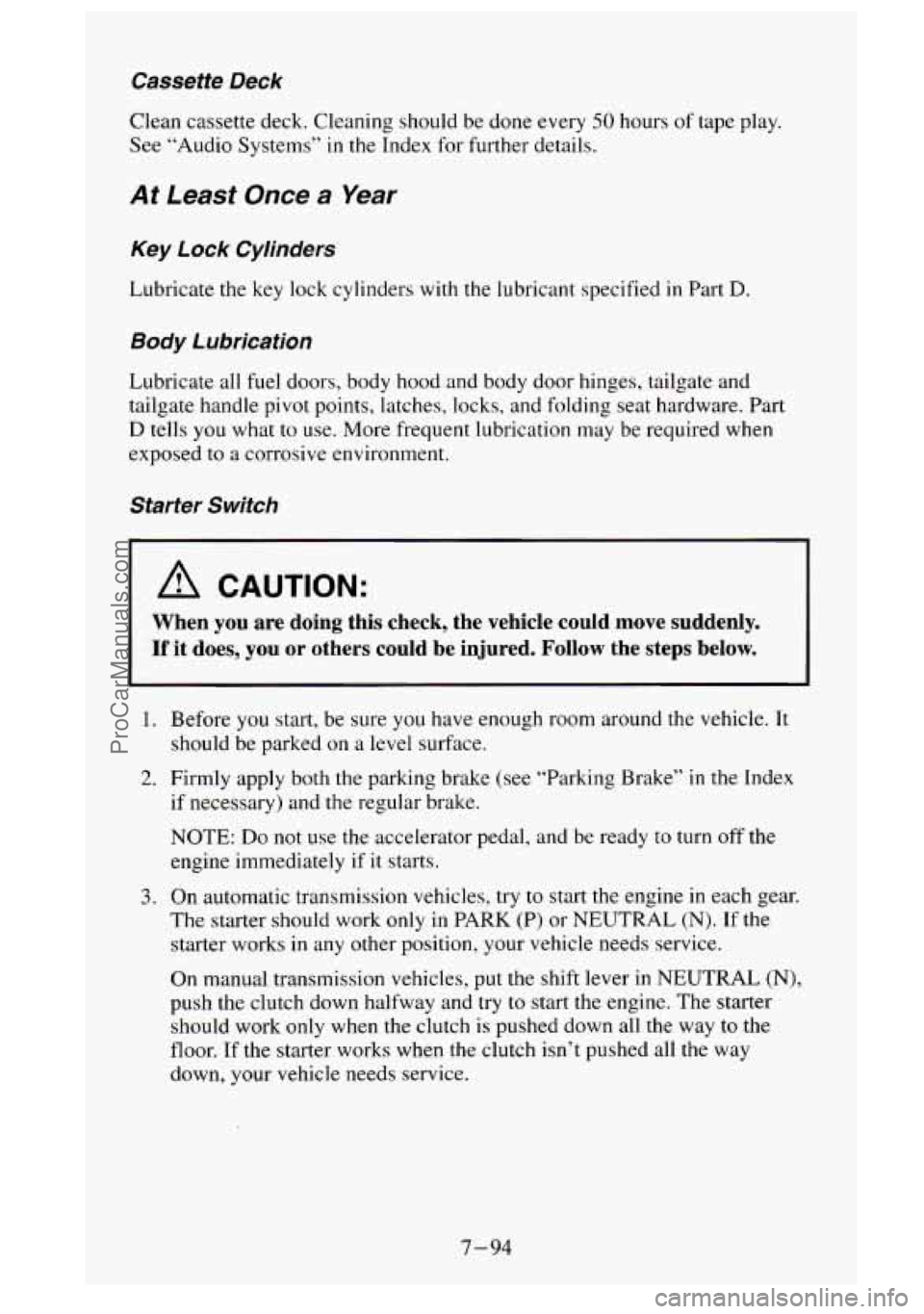
Cassette Deck
Clean cassette deck. Cleaning should be done every 50 hours of tape play.
See “Audio Systems”
in the Index for further details.
At Least Once a Year
Key Lock Cylinders
Lubricate the key lock cylinders with the lubricant specified in Part D.
Body Lubrication
Lubricate all fuel doors, body hood and body door hinges, tailgate and
tailgate handle pivot points, latches, locks, and folding seat hardware. Part
D tells you what to use. More frequent lubrication may be required when
exposed to
a corrosive environment.
Starter Switch
A CAUTION:
When you are doing this check, the vehicle could move suddenly.
If it does, you or others could be injured. Follow the steps below.
1. Before you start, be sure you have enough room around the vehicle. It
should be parked
on a level surface.
2. Firmly apply both the parking brake (see “Parking Brake” in the Index
if necessary) and the regular brake.
NOTE: Do not use the accelerator pedal, and be ready to turn off the
engine immediately
if it starts.
3. On automatic transmission vehicles, try to start the engine in each gear.
The starter should work only
in PARK (P) or NEUTRAL (N). If the
starter works in any other position, your vehicle needs service.
On manual transmission vehicles, put the shift lever in NEUTRAL
(N),
push the clutch down halfway and try to start the engine. The starter
should work only when the clutch is pushed down
all the way to the
floor. If the starter works when the clutch isn’t pushed all the way
down, your vehicle needs service.
7-94
ProCarManuals.com
Page 451 of 488
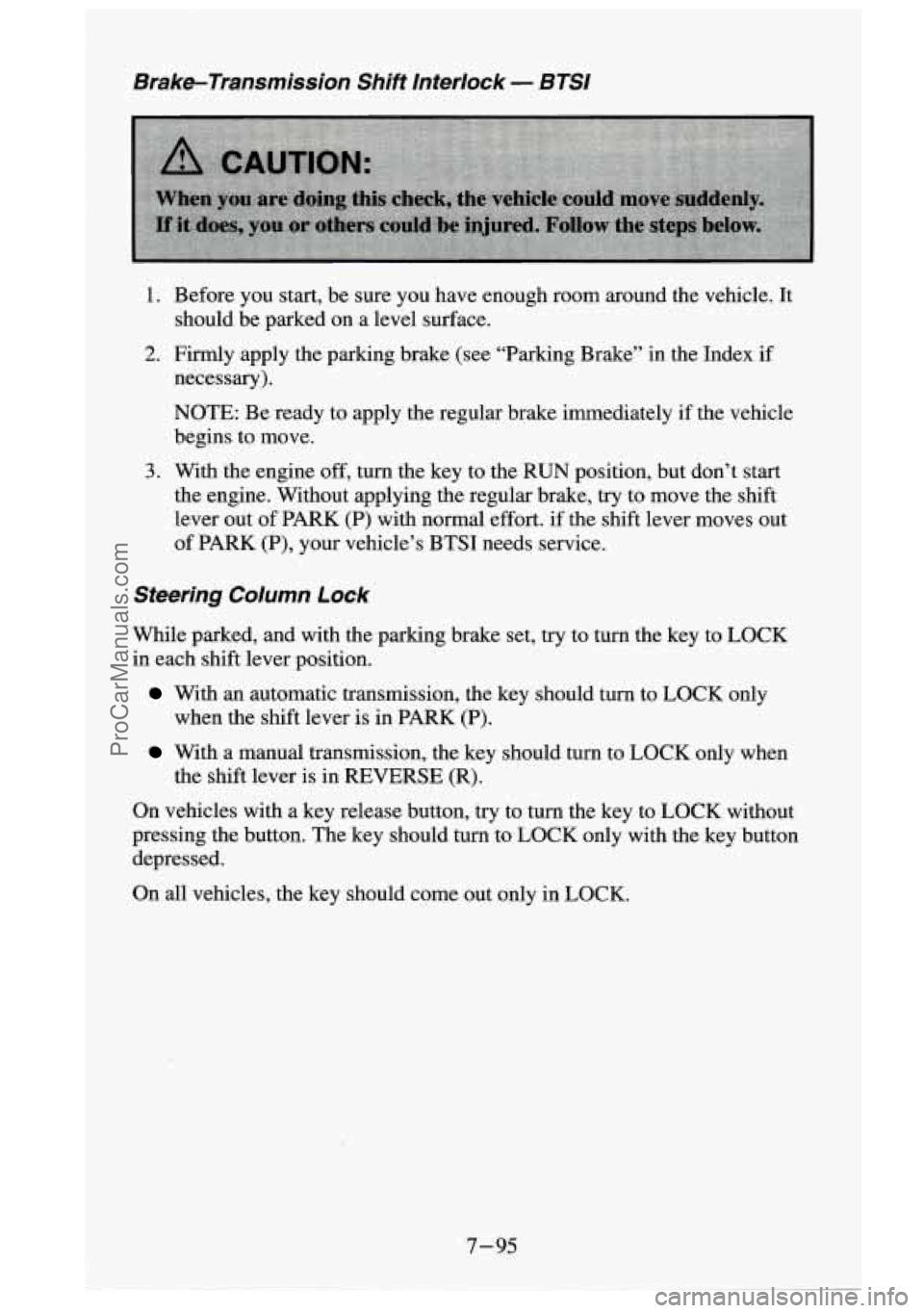
Brake-Transmission Shift Interlock - BTSI
1.
2.
3.
Before you start, be sure you have enough room around the vehicle. It
should be parked on a level surface.
Firrnly apply the parking brake (see “Parking Brake” in the Index
if
necessary).
NOTE: Be ready to apply the regular brake immediately if the vehicle
begins to move.
With the engine
off, turn the key to the RUN position, but don’t start
the engine. Without applying the regular brake,
try to move the shift
lever out of PARK (P) with normal effort. if the shift lever moves out
of PARK (P), your vehicle’s BTSI needs service.
Steering Column Lock
While parked, and with the parking brake set, try to turn the key to LOCK
in each shift lever position.
With an automatic transmission, the key should turn to LOCK only
With a manual transmission, the key should turn to LOCK only when
On vehicles with
a key release button, try to turn the key to LOCK without
pressing the button. The key should turn to LOCK only with the key button
depressed. when
the shift lever
is in PARK (P).
the shift lever is
in REVERSE (R).
On all vehicles, the key should come out only in LOCK.
7-95
ProCarManuals.com
Page 453 of 488
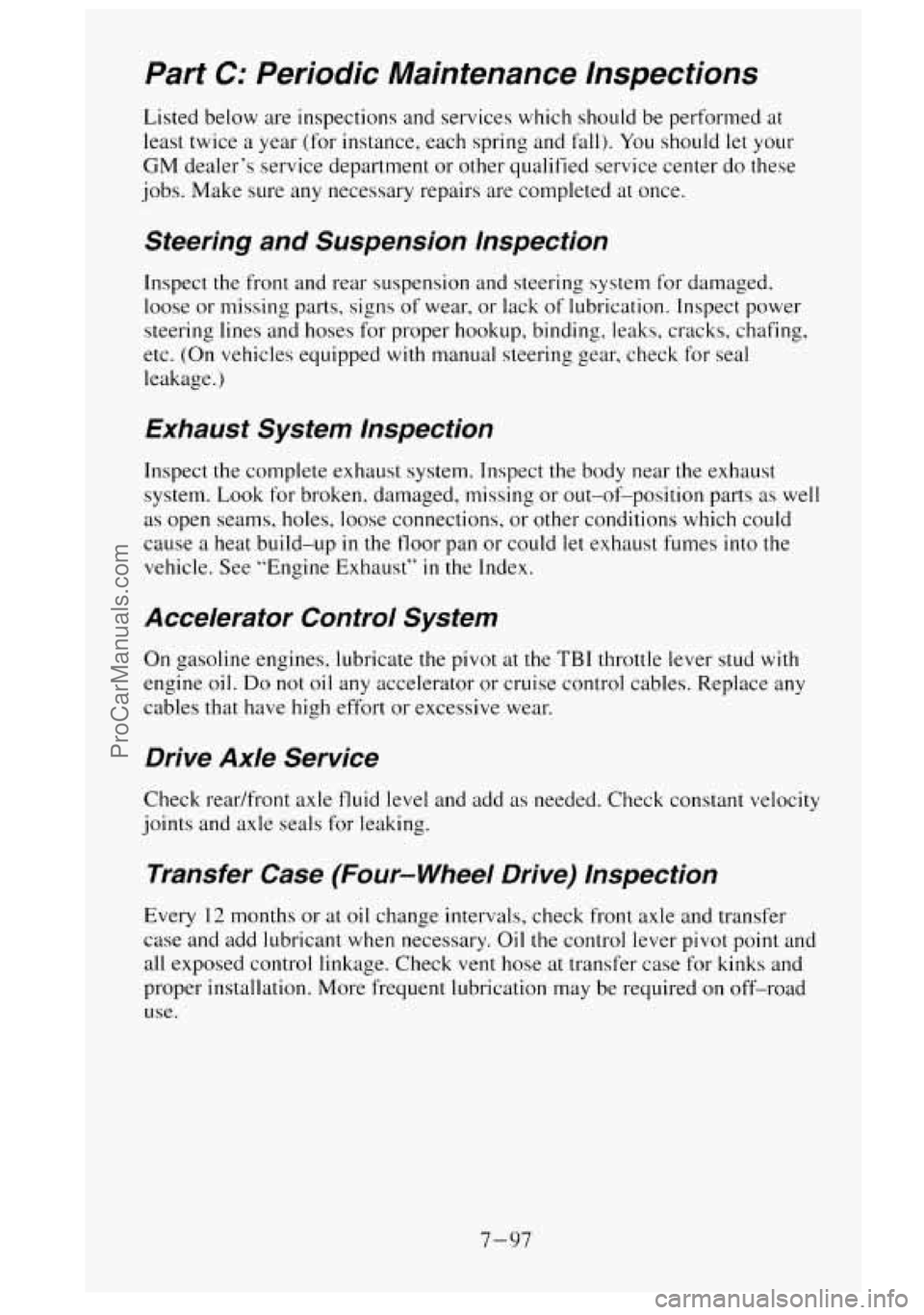
Part C: Periodic Maintenance lnspections
Listed below are inspections and services which should be performed at
least twice a year (for instance, each spring and
fall). You should let your
GM dealer’s service department or other qualified service center do these
jobs. Make sure any necessary repairs are completed at once.
Steering and Suspension Inspection
Inspect the front and rear suspension and steering system for damaged.
loose or missing parts, signs of wear,
or lack of lubrication. Inspect power
steering lines and hoses for proper hookup, binding, leaks, cracks, chafing,
etc. (On vehicles equipped with manual steering gear, check for seal
leakage.)
Exhaust System Inspection
Inspect the complete exhaust system. Inspect the body near the exhaust
system.
Look for broken. damaged, missing or out-of-position parts as well
as open seams, holes, loose connections,
or other conditions which could
cause a heat build-up
in the floor pan or could let exhaust fumes into the
vehicle. See “Engine Exhaust”
in the Index.
Accelerator Control System
On gasoline engines. lubricate the pivot at the TBI throttle lever stud with
engine
oil. Do not oil any accelerator or cruise control cables. Replace any
cables that have high effort or excessive wear.
Drive Axle Service
Check readfront axle fluid level and add as needed. Check constant velocity
Joints and axle seals for leaking.
Transfer Case (Four- Wheel Drive) Inspection
Every 12 months or at oil change intervals, check front axle and transfer
case and add lubricant when necessary. Oil the control lever pivot point and
all exposed control linkage. Check vent hose at transfer case for kinks and
proper installation. More frequent lubrication may be required on off-road
use.
7-97
ProCarManuals.com
Page 456 of 488
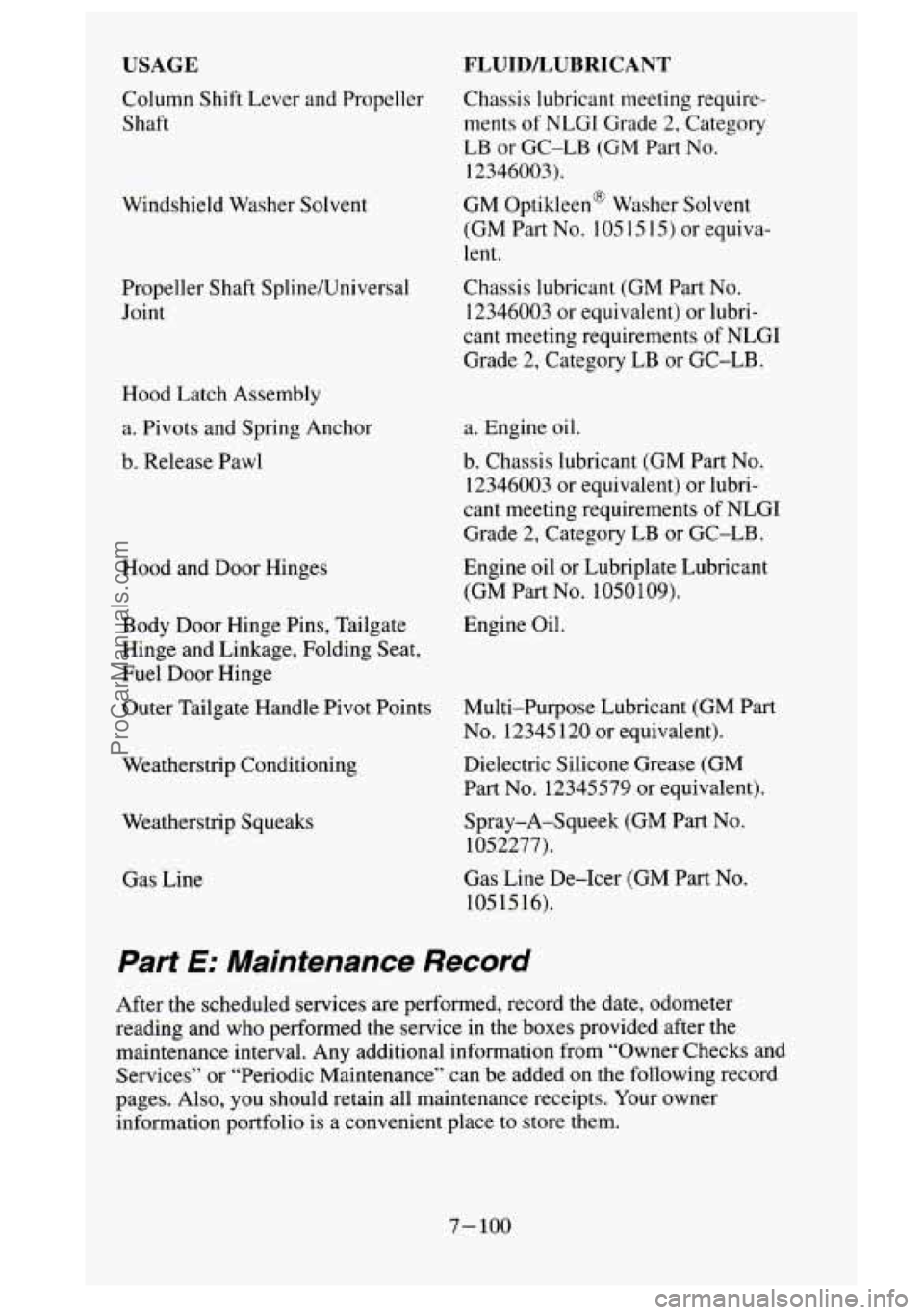
USAGE
Column Shift Lever and Propeller
Shaft
Windshield Washer Solvent
Propeller Shaft Spline/Universal
Joint
Hood Latch Assembly
a. Pivots and Spring Anchor
b. Release Pawl
Hood and Door Hinges
Body Door Hinge Pins, Tailgate
Hinge and Linkage, Folding Seat,
Fuel
Door Hinge
Outer Tailgate Handle Pivot Points
Weatherstrip Conditioning
Weatherstrip Squeaks
Gas Line
FLUIDLUBRICANT
Chassis lubricant meeting require-
ments
of NLGI Grade 2, Category
LB
or GC-LB (GM Part No.
12346003).
GM Optikleen’ Washer Solvent
(GM Part
No. 105 1 5 1 5) or equiva-
lent.
Chassis lubricant (GM Part
No.
12346003 or equivalent) or lubri-
cant meeting requirements
of NLGI
Grade 2, Category LB or GC-LB.
a. Engine oil.
b. Chassis lubricant (GM Part No.
12346003 or equivalent) or lubri-
cant meeting requirements
of NLGI
Grade 2, Category LB or GC-LB.
Engine oil or Lubriplate Lubricant
(GM Part
No. 1050109).
Engine Oil.
Multi-Purpose Lubricant (GM Part
No. 12345 120 or equivalent).
Dielectric Silicone Grease (GM
Part
No. 12345579 or equivalent).
Spray-A-Squeek (GM
Part No.
1 05 2277).
Gas Line De-Icer (GM Part No.
105 15 16).
Part E: Maintenance Record
After the scheduled services are performed, record the date, odometer
reading and who performed the service
in the boxes provided after the
maintenance interval. Any additional information from “Owner Checks and
Services” or “Periodic Maintenance” can be added on the following record
pages. Also, you should retain all maintenance receipts. Your owner
information portfolio
is a convenient place to store them.
7-100
ProCarManuals.com
Page 461 of 488
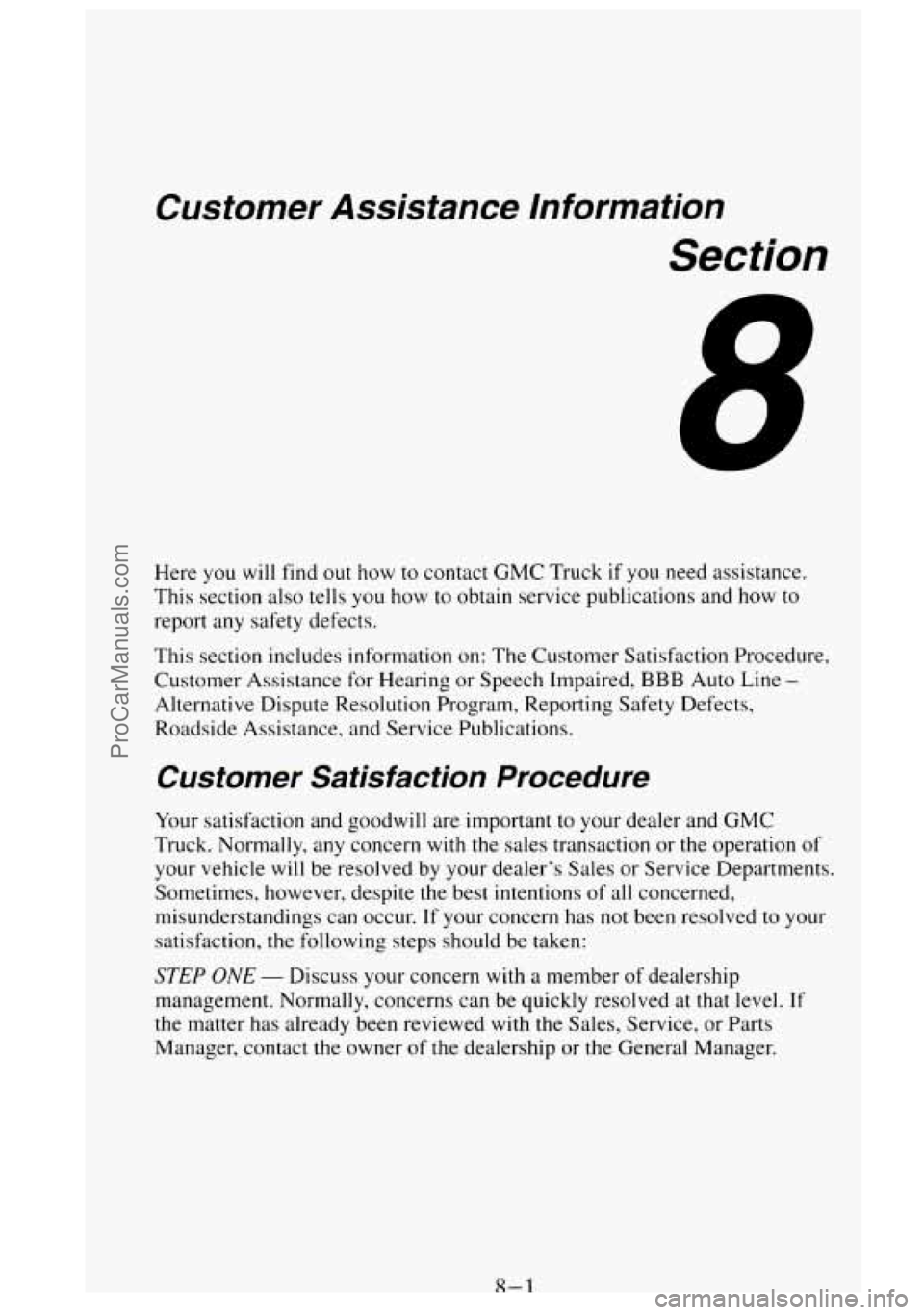
Customer Assistance Information
Section
Here you will find out how to contact GMC Truck if you need assistance.
This section also tells you how to obtain service publications and how to
report any safety defects.
This section includes information on:
The Customer Satisfaction Procedure,
Customer Assistance for Hearing or Speech Impaired,
BBB Auto Line -
Alternative Dispute Resolution Program, Reporting Safety Defects,
Roadside Assistance. and Service Publications.
Customer Satisfaction Procedure
Your satisfaction and goodwill are important to your dealer and GMC
Truck. Normally, any concern with
the sales transaction or the operation of
your vehicle will be resolved by your dealer’s Sales or Service Departments.
Sometimes, however, despite the best intentions
of all concerned,
misunderstandings can occur.
If your concern has not been resolved to your
satisfaction,
the following steps should be taken:
STEP ONE - Discuss your concern with a member of dealership
management. Normally, concerns can be quickly resolved at that level.
If
the matter has already been reviewed with the Sales, Service, or Parts
Manager, contact the owner of the dealership or the General Manager.
8-1
ProCarManuals.com
Page 465 of 488
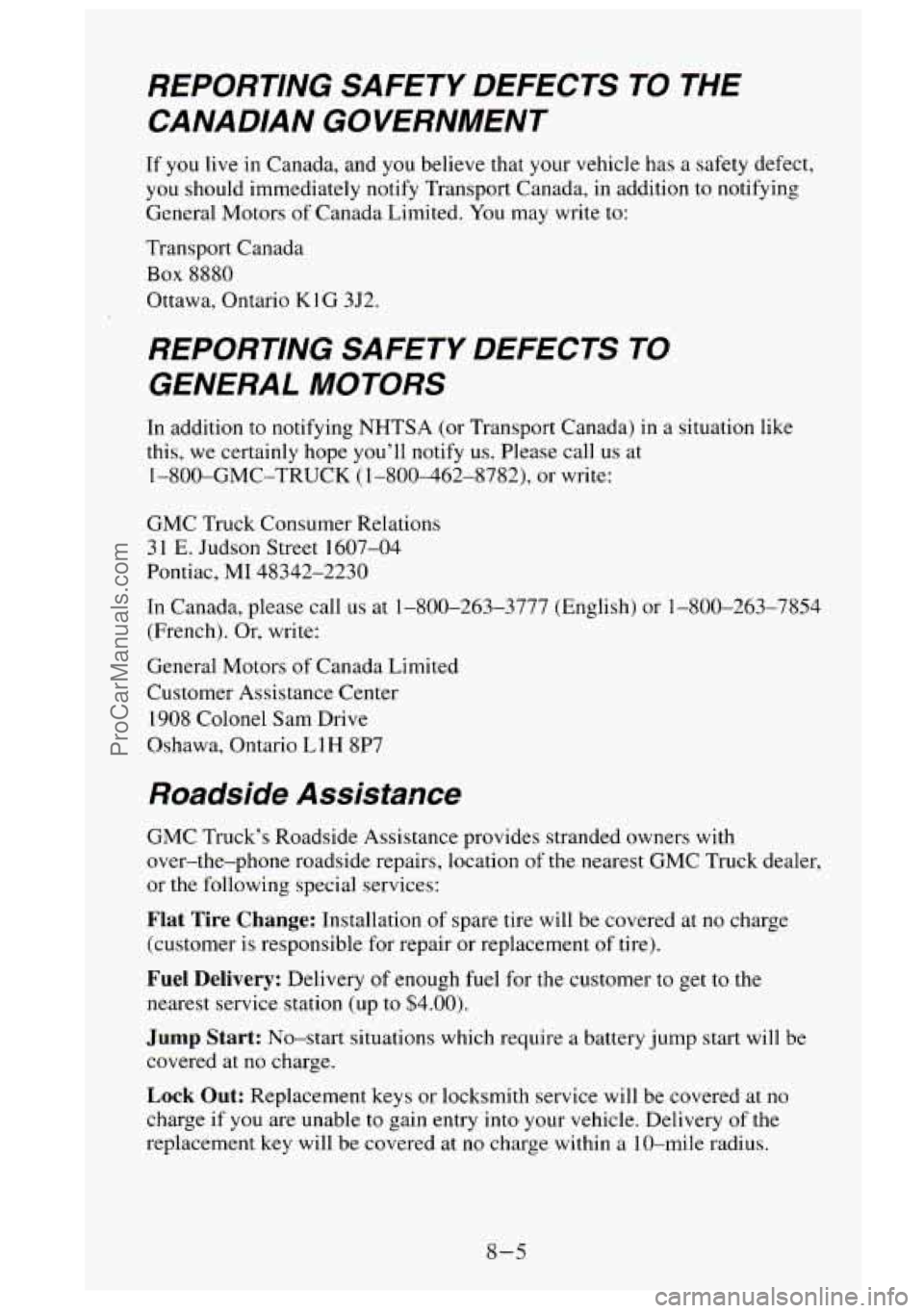
REPORTING SAFETY DEFECTS TO THE
CANADIAN GOVERNMENT
If you live in Canada, and you believe that your vehicle has a safety defect,
you should immediately notify Transport Canada, in addition
to notifying
General Motors of Canada Limited.
You may write to:
Transport Canada
Box 8880
Ottawa, Ontario K1 G 352.
REPORTING SAFETY DEFECTS TO GENERAL MOTORS
In addition to notifying NHTSA (or Transport Canada) in a situation like
this, we certainly hope
you’ll notify us. Please call us at
1-800-GMC-TRUCK (1-800-462-8782), or write:
GMC Truck Consumer Relations
3
1 E. Judson Street 1607-04
Pontiac, MI 48342-2230
In Canada, please call
us at 1-800-263-3777 (English) or 1-800-263-7854
(French). Or, write:
General Motors of Canada Limited
Customer Assistance Center
1908 Colonel Sam Drive
Oshawa, Ontario
LlH 8P7
Roadside Assistance
GMC Truck’s Roadside Assistance provides stranded owners with
over-the-phone roadside repairs, location of the nearest GMC Truck dealer,
or the following special services:
Flat Tire Change: Installation of spare tire will be covered at no charge
(customer
is responsible for repair or replacement of tire).
Fuel Delivery: Delivery of enough fuel for the customer to get to the
nearest service station (up to $4.00).
Jump Start: No-start situations which require a battery jump start will be
covered at
no charge.
Lock Out: Replacement keys or locksmith service will be covered at no
charge if you are unable to gain entry into your vehicle. Delivery of the
replacement key will be covered at no charge within a 10-mile radius.
8-5
ProCarManuals.com
Page 466 of 488
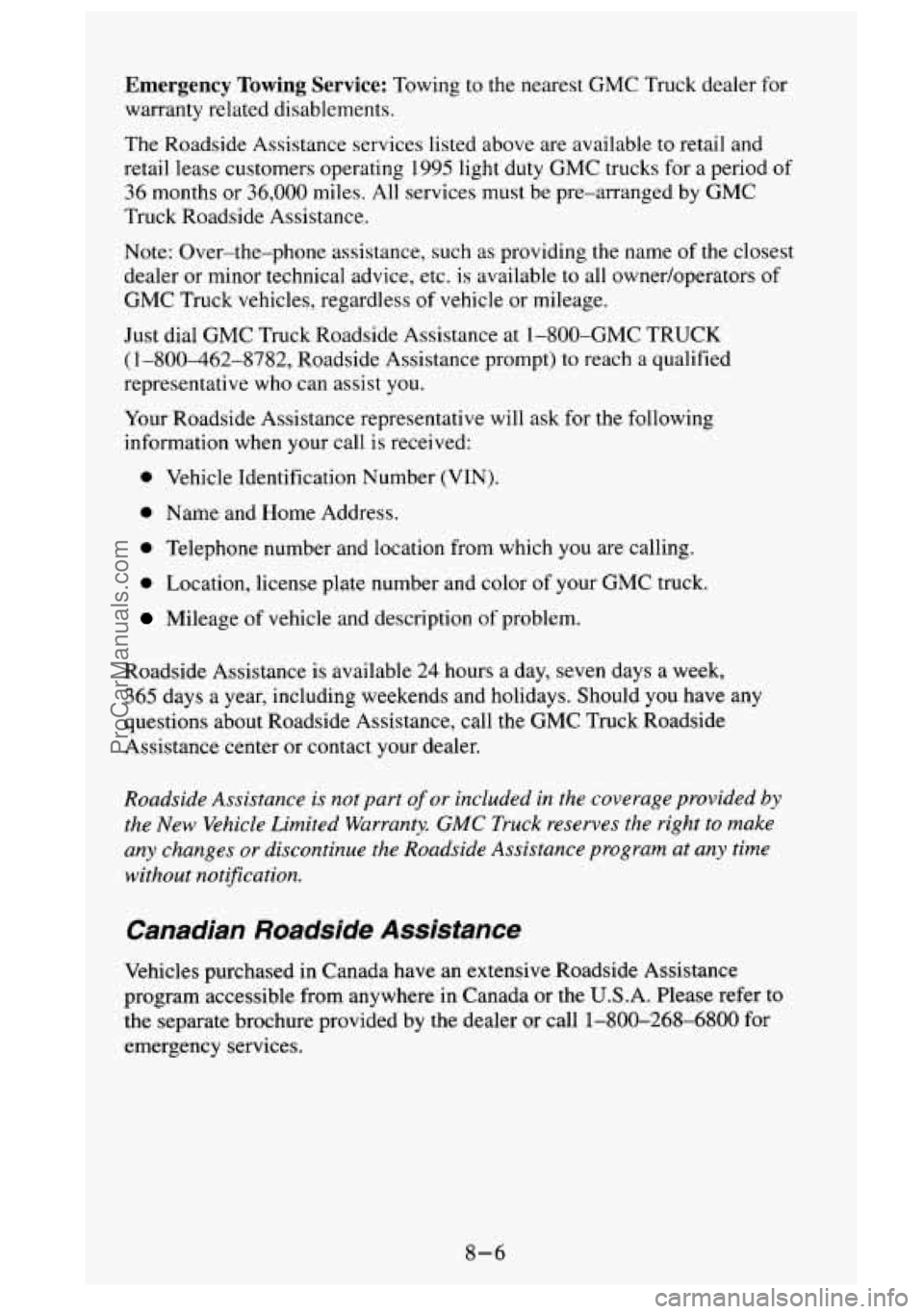
Emergency Towing Service: Towing to the nearest GMC Truck dealer for
warranty related disablements.
The Roadside Assistance services listed above are available to retail and
retail lease customers operating
1995 light duty GMC trucks for a period of
36 months or 36,000 miles. All services must be pre-arranged by GMC
Truck Roadside Assistance.
Note: Over-the-phone assistance, such as providing the name of the closest
dealer or minor technical advice, etc. is available
to all owner/operators of
GMC Truck vehicles, regardless of vehicle or mileage.
Just dial GMC Truck Roadside Assistance at 1-800-GMC TRUCK
(1-800-462-8782, Roadside Assistance prompt) to reach a qualified
representative who can assist
you.
Your Roadside Assistance representative will ask for the following
information when your call
is received:
0 Vehicle Identification Number (VIN).
0 Name and Home Address.
0 Telephone number and location from which you are calling.
0 Location, license plate number and color of your GMC truck.
Mileage of vehicle and description of problem.
Roadside Assistance is available
24 hours a day, seven days a week,
365 days a year, including weekends and holidays. Should you have any
questions about Roadside Assistance, call the GMC Truck Roadside
Assistance center or contact your dealer.
Roadside Assistance is not part of or included in the coverage provided by
the New Vehicle Limited Warranty. GMC Truck reserves the right to make
any changes or discontinue the Roadside Assistance program at any time
without notification.
Canadian Roadside Assistance
Vehicles purchased in Canada have an extensive Roadside Assistance
program accessible from anywhere in Canada or the U.S.A. Please refer
to
the separate brochure provided by the dealer or call 1-800-268-6800 for
emergency services.
8-6
ProCarManuals.com